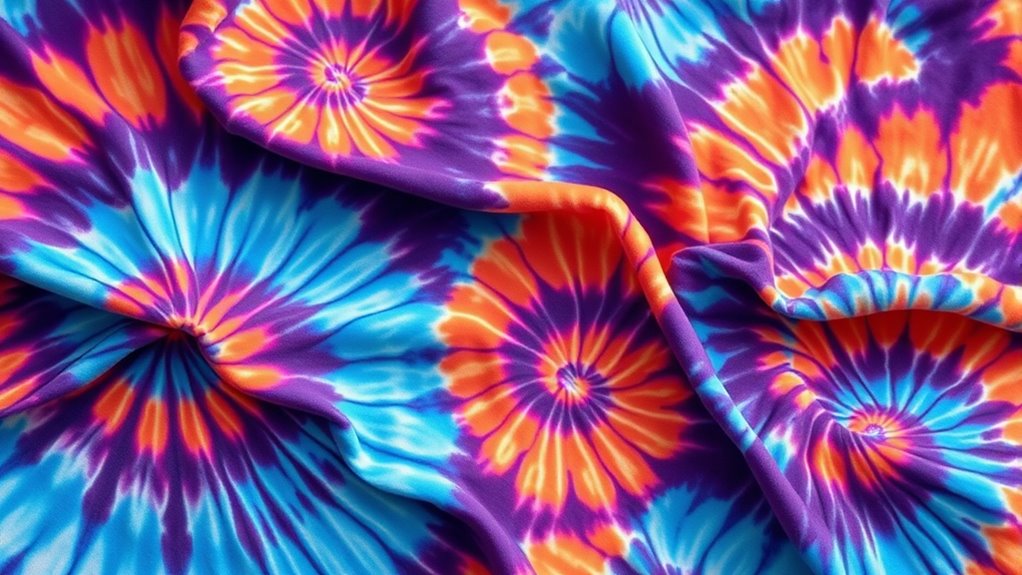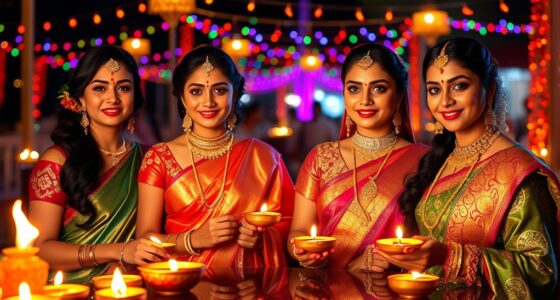Tie-dye has roots stretching back thousands of years across different cultures, where it was used to express identity, spiritual beliefs, and social status. Early methods involved manual folding and natural dyes, creating vibrant patterns with symbolic meanings. The craft evolved with the introduction of synthetic dyes, fueling its rise in popularity during the 1960s counterculture. Today, new technologies and eco-friendly practices continue to shape its future, offering fresh ways to explore this timeless art—if you want to learn more, keep exploring its fascinating journey.
Key Takeaways
- Tie-dye has ancient origins across Africa, Asia, and other continents, with cultural meanings linked to identity, spirituality, and social status.
- Traditional methods used natural dyes and manual techniques like folding and tying, reflecting regional symbolism and ceremonial practices.
- The invention of synthetic dyes in the 19th and 20th centuries enhanced color vibrancy, durability, and design complexity, expanding global popularity.
- In the 1960s, tie-dye became a symbol of counterculture and individual expression, influenced by new fabric treatments and psychedelic designs.
- Contemporary trends focus on eco-friendly dyes, digital printing, and sustainable practices, blending cultural heritage with modern innovation.

Have you ever wondered where the vibrant art of tie-dye originated? It’s a colorful story that spans thousands of years and continents, rooted deeply in cultural symbolism and shaped by technological innovations. Many ancient societies used tie-dye techniques not just to decorate fabric, but to communicate identity, social status, and spiritual beliefs. For example, in Africa, specific patterns and colors held symbolic meanings, representing different tribes or rites of passage. Similarly, in Asia, particularly India and Japan, tie-dye methods like Bandhani and Shibori evolved as intricate crafts tied to religious ceremonies and cultural symbolism. These practices weren’t merely decorative; they conveyed messages about community, spirituality, and hierarchy.
Tie-dye’s roots run deep in cultural symbols and ancient craft traditions worldwide.
As centuries passed, technological innovations profoundly advanced tie-dye techniques, making the process more accessible and diverse. Early methods relied on manual folding, tying, and dyeing with natural dyes derived from plants, minerals, and insects. These natural dyes offered rich, vibrant hues but also posed challenges—colors could fade or bleed unpredictably. The development of synthetic dyes in the late 19th and early 20th centuries revolutionized tie-dyeing by offering brighter, more consistent colors, and making the craft more durable and affordable. This shift allowed more people to experiment with bold patterns and elaborate designs, fueling global popularity.
In the 1960s, tie-dye experienced a major resurgence as a symbol of counterculture and individual expression. During this era, technological innovations like chemical dyes and new fabric treatments enabled artists and enthusiasts to push the boundaries of traditional patterns. The vibrant, psychedelic designs became an emblem of freedom, peace, and rebellion, especially within the youth movement in the United States. This cultural symbolism transformed tie-dye from a traditional craft into a powerful statement, echoing themes of unity and nonconformity.
Today, the history of tie-dye continues to evolve. Modern advancements, such as eco-friendly dyes and digital fabric printing, are shaping new trends. These technological innovations make it easier to produce intricate, customized designs while reducing environmental impact. Additionally, contemporary artists are exploring sustainable dyeing techniques to further align the craft with eco-conscious values. Whether in high fashion, streetwear, or sustainable fashion movements, the core elements of cultural symbolism and technological progress persist. The art of tie-dye now blends ancient traditions with contemporary innovations, reflecting a dynamic history that remains as vibrant as the patterns it creates. So, every time you see or wear a tie-dye piece, you’re partaking in a colorful legacy that spans centuries of cultural meaning and technological ingenuity.
Frequently Asked Questions
How Did Tie-Dye Spread Globally in the 20TH Century?
You saw how tie-dye spread globally in the 20th century through the rise of the hippie movement, which embraced its vibrant, free-spirited style. As popularity soared, mass production techniques made tie-dye more accessible and affordable, fueling its worldwide craze. You experienced its influence in fashion, music festivals, and cultural icons, making tie-dye a symbol of rebellion, peace, and individuality across diverse cultures around the globe.
What Are the Health Risks Associated With Traditional Tie-Dye Methods?
You should be aware that traditional tie-dye methods pose health risks like chemical exposure and skin irritation. Handling dyes and mordants without proper protection can lead to skin rashes or more serious health issues. Always wear gloves and work in a well-ventilated area to minimize these risks. Avoid direct contact with chemicals and wash your hands thoroughly afterward to keep your skin safe and healthy during the dyeing process.
How Do Different Cultures Interpret Tie-Dye Symbolism?
You might think tie-dye is just colorful fabric, but different cultures interpret its symbolism deeply. In some traditions, vibrant patterns represent spiritual awakening or religious significance, revealing inner harmony. Ironically, while Western cultures often see tie-dye as casual fun, others see it as a powerful expression of cultural identity. You’re reminded that beneath those bright hues lie complex stories of cultural symbolism and sacred meaning, waiting to be understood.
Can Tie-Dye Be Considered a Form of Cultural Appropriation?
Yes, tie-dye can be considered a form of cultural appropriation when you use designs rooted in specific cultural boundaries without understanding or respecting their significance. It’s important to recognize that tie-dye is more than just an artistic expression; it holds cultural meaning for certain communities. To avoid appropriation, you should learn about its origins and honor the traditions behind the patterns, respecting their cultural boundaries.
What Sustainable Practices Are Emerging in Modern Tie-Dye Production?
You can embrace sustainable practices in modern tie-dye by using natural dyes and eco-friendly pigments. These methods reduce chemical waste and lessen environmental impact. You might also opt for organic fabrics and water-saving techniques, like low-water dyeing processes. By choosing sustainable materials and dyes, you support eco-conscious fashion and help preserve the planet, all while creating vibrant, unique designs that reflect your commitment to environmental responsibility.
Conclusion
You’ve seen how tie-dye weaves through history, from ancient cultures to modern trends. You’ve learned how it connects traditions, expresses individuality, and sparks creativity. You realize that tie-dye isn’t just about colors, patterns, or fashion—it’s about embracing change, celebrating uniqueness, and finding joy in self-expression. So, as you wear your next tie-dye piece, remember: it’s a symbol of history, a reflection of spirit, and a celebration of you.









